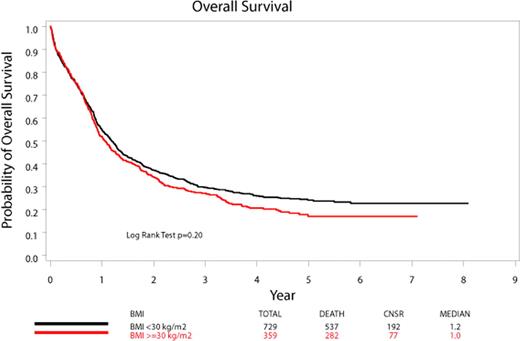Abstract
Abstract 2568
Obesity is associated with an increased risk of development of adult AML (Relative Risk approx. 2-fold) (Ross J, Cancer Epidemiol Biomarkers Prev 2004;13:1810) and significantly higher mortality in pediatric AML (Lange B, JAMA 2005;293:203). We therefore examined the association of obesity with presenting characteristics in 2 recent large ECOG phase III adult AML trials to determine whether there was a unique clinical and genetic phenotype, and also the impact of obesity on clinical outcomes (complete remission - CR; early death - ED; overall survival - OS) in association with other known risk factors. The impact of obesity on receiving full-dose daunorubicin (D) was also evaluated in these studies. We included patients (pts) from E1900 receiving standard infusional cytarabine with intensified D (45 vs. 90mg/m2) in adults age ≤60 yrs (NEJM 2009;361:1249), and from E3999 receiving conventional intensive chemotherapy +/− the MDR-inhibitor zosuquidar in adults age >60 yrs (Blood 2010;116:4077). Obesity was defined as Body Mass Index (BMI) >30kg/m2.
Pt baseline characteristics were compared using Fisher's exact (categories variables) or Wilcoxon rank sum tests (continuous variables). Logistic regression models were used to examine the association between obesity and CR or ED; Cox models stratified on induction treatment arms were used to examine the association between obesity and OS. Multivariate models to examine the effect of Obesity controlled for known prognostic factors (including cytogenetics & secondary AML - sAML).
A total of 1089 pts (E1900, n=651; E3999, n=438) with available BMI data were included, the median follow-up of living pts is 4.7 yrs. Obesity was prevalent, with n=359 (33%) of pts with a BMI>30 at presentation. For all patients, median BMI was 27.1 (range 16.7–93.0); for non-obese patients median BMI was 25.0 (range 16.7–29.96) while for obese patients the median BMI was 34.0 (range 30.0–93.0).
Obese pts were older (p=0.06), and significantly more likely female gender (p=0.05), ECOG PS>0 (p=0.01), & Intermediate Risk cytogenetics (p=0.006) but not sAML (14% overall, p=ns). Genotyping for FLT3 & MLL was performed in E1900 pts (age ≤60yrs): there was no difference in incidence of FLT3-ITD, but lower incidence of MLL-PTD was observed (p=0.08) in obese pts (not performed in E3999) (See Table).
| . | Obese (BMI>30) . | Non-Obese . | P-value . |
|---|---|---|---|
| Median Age | 59yrs | 56yrs | 0.06 |
| Female gender | 51% | 44.5% | 0.05 |
| Intermediate Cytogenetics | 42.3% | 35.5% | 0.006 |
| PS>0 | 64.1% | 57.6% | 0.01 |
| MLL-PTD | 1.7% | 3.6% | 0.08 |
| FLT3-ITD | 14.8% | 12.5% | 0.31 |
| . | Obese (BMI>30) . | Non-Obese . | P-value . |
|---|---|---|---|
| Median Age | 59yrs | 56yrs | 0.06 |
| Female gender | 51% | 44.5% | 0.05 |
| Intermediate Cytogenetics | 42.3% | 35.5% | 0.006 |
| PS>0 | 64.1% | 57.6% | 0.01 |
| MLL-PTD | 1.7% | 3.6% | 0.08 |
| FLT3-ITD | 14.8% | 12.5% | 0.31 |
Overall, only 3.7% of pts received <90% of intended D dose. However obesity was significantly associated with receiving <90% intended D dose: in E1900, 11% of obese pts received <90% intended D (45mg/m2 cohort, p<0.001; 90mg/m2 cohort p=0.002), while in E3999 4% obese pts received <90% intended D (45mg/m2, p=0.07). There was no clear difference in toxicity/adverse events during initial induction therapy reported in obese vs. non-obese pts.
On multivariate analysis obesity was not significantly associated with achieving CR (p=0.09), and had no direct independent association with ED (p=0.38).
Kaplan-Meier plots of OS are shown in Figure. On multivariate analysis, age (p<0.001); ECOG PS (p<0.001); cytogenetic risk group (p<0.001); sAML (p=0.03); gender (p=0.05); and peripheral blasts (p=0.003) but not obesity were significantly associated with OS. Receiving <90% intended D dose was marginally associated with increased hazard ratio for OS (HR 1.50, 95%CI 0.98–2.28, p=0.06).
Obesity is associated with specific presenting clinical characteristics in adult AML (female, older, PS>0, Int. risk cytogenetics, less frequent MLL-PTD), but has no direct impact on CR, ED or OS in the setting of a controlled therapeutic trial. Obese pts are at risk of receiving <90% intended D dose, which may impact OS. This analysis suggests that factors that predispose to adult AML may present with a unique clinical phenotype.
No relevant conflicts of interest to declare.
Author notes
Asterisk with author names denotes non-ASH members.


This feature is available to Subscribers Only
Sign In or Create an Account Close Modal